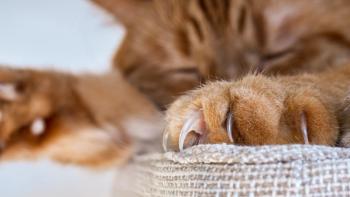
How to apply practical suturing, stapling, wound drainage techniques
Dr. Tim Crowe outlines three practical surgical techniques that are effective in managing traumatic or surgical wounds.
There are three practical surgical techniques that can be effective in the management of either traumatic or surgical wounds: use of a suture (polybutester) that has an inherent elastic property that stretches when edema or tension occurs; use of skin staples to rapidly close wounds; and use of suction drains that effectively obliterate dead space. Each of the described uses discussed have been applied in literally hundreds of clinical cases with time savings and a decrease in complication rate being realized.
Suture properties
Polybutester (Novafil, by Davis & Geck) is a unique monofilament non-absorbable suture material available since the mid-1980s. It has an elastic property that allows for edema and tension to be accommodated for, thus preventing strangulation of the tissues' blood supply and also protects against tissue tearing and suture breakage. I began using the material first for routine fascia and skin closure in 1985 because it had properties that were similar to polypropylene, being non-reactive and with an excellent track record for superiority in strength and knot security. After several hundred abdominal fascial continuous closures without complications, I expanded its use to the stomach, intestine, esophagus, blood vessels, other fascia and the skin. Today, it is a suture I reach for when faced with closures that are prone to significant tension and edema.
Because it has a superior stretch quality, the polybutester is used as a continuous, interrupted, near-far-far-near (NFFN) and either interrupted or continuous vertical mattress suture for fascial and skin closures. Size 2-0 to 4-0 Novafil are used to bring the subcutaneous tissues and skin together with the same exterior suture. Since I am not in favor of burying suture of any kind in traumatic wounds because it enhances the chance for infection to develop, I have used the polybutester a great deal for this type of closure. The most common pattern used is the NFFN with the far bites providing closure of the deep subcutaneous tissues and the near bites apposing the skin. Research has shown that even having one buried suture in a clean-contaminated wound increases the likelihood of infection occurring by 200 percent. Using the vertical mattress or the NFFN allows for apposition of the deep and superficial subcutaneous and subdermal layers without requiring the buried sutures. Using the polybutester also prevents strangulation of tissues and resists pullout and suture breakage. Because of its bio-inertness, strength and knot security, it is used in human medicine for cardiovascular applications.
Polybutester is available as swaged-on needles of cutting and taper variety and in a fine vascular type or a general closure-circle.
Skin stapling
The use of skin staples saves significant amounts of surgical closure time when compared to standard suture closure. This equates to a more economical way to close traumatic and intentional surgical wounds, less wound infection and less overall complications. In a simple, unpublished study, I compared the time required to close 4 cm skin incisions with simple interrupted sutures, a simple continuous suture, or staples applied with the use of a commercial staple gun that holds 35 skin staples (Kendall Animal Health).
The interrupted suture closure took on average 90 seconds, the continuous closure 50 seconds and the staple closure 12 seconds. Clinical healing was similar in all cases except a few of the staples had fallen out or had become turned, yet at the time of suture or staple closure (at 10 days to 14 days), the end result and cosmetic effect was similar in all closures. Removal of staples was judged to be easier and less stressful for the patient with the staples versus skin sutures. From this study and clinical experience, I recommend staples over suture closure with traumatic or surgically induced skin incisions whenever possible. With small traumatic lacerations that are clean and not requiring debridement, the use of skin staples to close them has been found to be quite practical, often only requiring a local anesthetic and mild sedation. In some cases, the wound is simply pinched together and the staple gun fired as needed to effect a closure without the need for even a local block with less discomfort to the patient. The only contraindication for the use of skin staples is in very fine skin closure when the tissues involved are delicate, e.g., the eyelid.
Skin staples are available in either regular or wide width with usually 35 staples together in a disposable plastic gun. The staple guns are available from many manufacturers. I use the regular width on the skin wounds of cats and some dogs where the skin is thin or their size is generally under 30 kg. Although the wider staples can be used exclusively in all dogs and cats, in my experience the wider staples are more prone to rotate or fall out, especially in cats and dogs less than 20 kg in weight or in thin-skinned auxiliary and inguinal areas where much movement occurs.
Photo 1: Close up of a staple in place.
Steps in staple closure
- Perform the preparation of skin and hair (by widely prepping) if this has not been done prior;
- Irrigate the tissues just prior to closure;
- Use an Adson, Brown-Adson or other similar forceps to pick up the edges of the wound and gain approximation;
- While holding the apposition, place a staple in the skin to appose both sides of the wound (there will be a slight mounding effect brought about by the staples. This is preferred to having any gap between the staples;
- Complete the skin closure by placing one staple approximately every centimeter (Photo 1, p. 6). In some incisions where there is some tension or thinness there may be a need to place two staples every centimeter.
Emergency cases
In the emergency management of traumatic wounds, the advantages of staple closure of small lacerations versus suturing are speed, no laceration surgical pack or suture is necessary and most often, only a small amount of sedation, if any, is needed. The same is true for the amount of local anesthetic required. In many cases, I just spray lidocaine or ethyl chloride into the laceration enough to provide analgesia. With proper application of skin staples there is a small gap between the top of the staple and the skin, allowing for swelling. Patients then tolerate the staples better with less effort to try and remove them.
Other applications for skin staples include:
- nTo hold nasal feeding and oxygen tubes in place;
- To hold IV and epidural catheters in position;
- To hold traumatic skin flaps in position over the subcutaneous bed from where they originated;
- For marking wound entrances and incision lines for radiographs;
- For holding dressings and bandages in place;
- As a skin "electrode" for ECG leads, where the alligator clips are clipped to the staple that is inserted into the skin, allowing for good ECG tracings and better patient comfort when compared to the use of alligator clips being attached to the patient.
Suction drains
The definition of wound dead space is a space where, after its closure, air is present. According to surgical research performed in laboratory animals there are only two ways that dead space can be effectively obliterated. These are by using compression dressings that literally force the air out of the wound pocket; and by using a multi-holed drain that is applied to constant suction, which draws the air out of the pocket. Silicone suction drains and the suction reservoirs are available commercially from several sources and can be autoclaved and used as well (Photo 2, p. 7).
Photo 2: A silicone suction drain and reservoir that have been autoclaved. These types of drains effectively tolerate steam sterilization.
Although somewhat controversial, some surgeons believe that subcutaneous subcuticular sutures that also suture into superficial fascia are effective in closing wound dead space. Others believe suturing is only partially effective in obliterating wound dead space. A study published about 10 years ago suggested that suturing and the use of closed suction drains are more effective than either of the techniques used alone. Older studies revealed that the suture technique alone causes compartmentalization of the dead space but does not close dead space as well as suction drains when the two methods were compared individually. Penrose drains are only effective in obliterating dead space if external compression is also applied to the wound. My clinical experience with these methods mimics what has been reported from laboratory findings. I use a suction drain in place of tacking sutures as the principal method of managing dead space along with use of external compression dressings. I rarely use Penrose drains in clean or surgically created wounds and dead space associated with them unless the wound can be compressed with an external dressing. Research has also shown that unless a Penrose drain is sterilely covered that within six hours the bacteria that come in contact with the exposed drain are also able to be cultured at the tip of the inside portion of the drain. Therefore, their external portions should always be under a dressing if at all possible. Studies have shown that suction drains with a small amount of antibiotic ointment placed at their exit sites carries a very low risk of infection compared to uncovered Penrose drains.
Photos 3 A-D (top left to bottom right): A dog that had a very large tumor on the side of her chest that was removed. A. Before removal; B. After removal showing incision and reservoir bulb of suction drain in place; C. Close-up of active suction reservoir and the skin staples; D. Following an inner dressing change using a trap door effect so that further dressings can be changed easily without removing the entire outer bandage. Note the use of safety pins to reclose the opened outer bandage.
Placement and activation of a suction drain:
- Create a small access channel for the drain to course through from subcutaneous dead space pocket to a subdermal location approximately 4 cm to 5 cm long by pushing the tips of a hemostat from the pocket through the subdermal fat.
- Using the tip of a 15 blade, make a small opening in the skin over the bulge where the tips of the curved hemostat are palpated and push the tips through the hole to the outside.
- Grasp the multi-holed end of the silicone drain and pull it through the access channel.
- Position the section of the drain with multiple holes in the subcutaneous pocket so it extends the entire length of the pocket.
- Secure the drain at the skin exit site with a suture wrapped around it multiple times.
- Close the wound edges routinely with a subcuticular continuous pattern followed by either skin staples or sutures.
- Attach the external end of the drain to the silicone bulb reservoir that accompanies the drain.
- Open the evacuation port on the suction bulb and squeeze the bulb to empty the air out and then reclose the port. The collapsed silicone bulb then provides 30 mm to 50 mm Hg of suction on the drain at all times. Other suction reservoir systems can be used as well as the silicone bulb. One is made with a spring inside (Schnyder Hemavac). Another has a reservoir inside a plastic bottle and the bottle is manually collapsed (Davol). Homemade devices can be used involving syringes where the plunger is held out with needle, pin or charged Vacutainers.
The suction drain is kept in place for a minimum of several days. The reservoirs need to be recharged as necessary to keep the suction continuous (Photo 3 A-C, p. 8). The suction literally draws the entire pocket closed and keeps it closed for several days, allowing fibrin adhesion formation to occur thus joining the two surfaces together. The drain continues to be activated until fluid removed on a daily basis is next to nothing. A rule of thumb is when the amount drained is at or below 1 ml/kg/day. This fluid represents the amount of lymphatic fluid that is commonly in the wound's region normally that can be collected. A simple method of changing internal dressings in bandages used to protect closed surgical wounds involves the creation of trap doors in the outer bandages with the closure being done with safety pins (Photo 3, p. 8).
Suggested Reading
Newsletter
From exam room tips to practice management insights, get trusted veterinary news delivered straight to your inbox—subscribe to dvm360.






